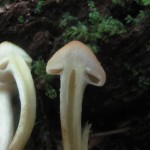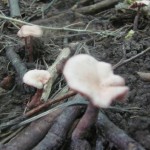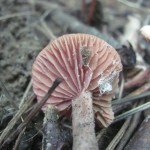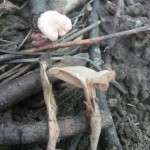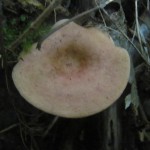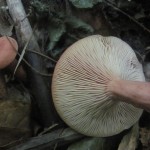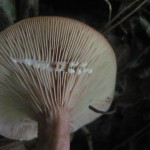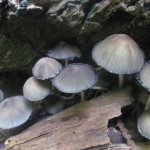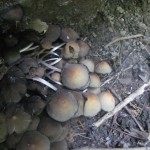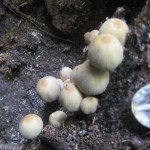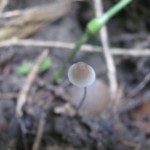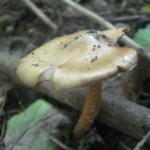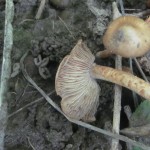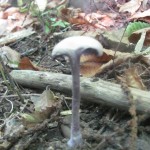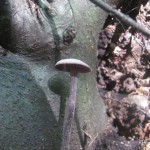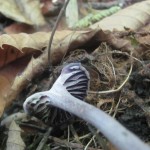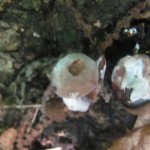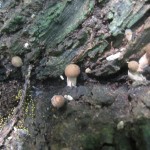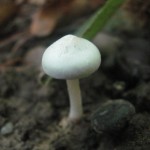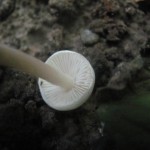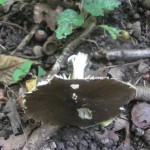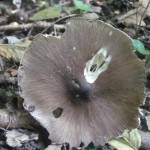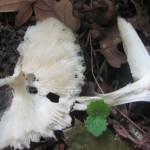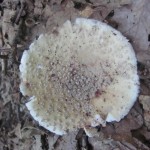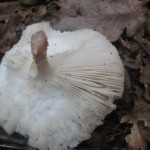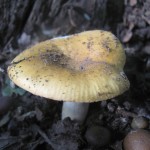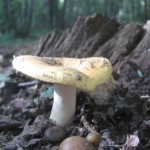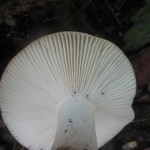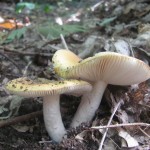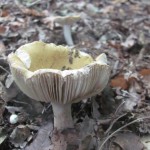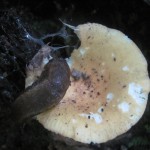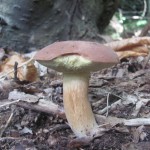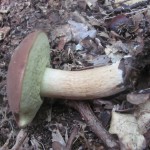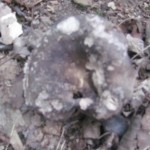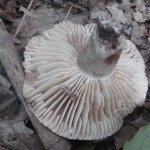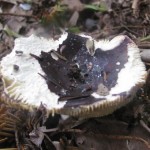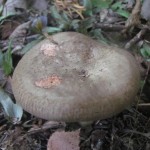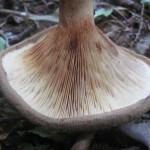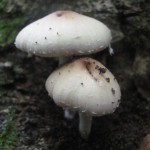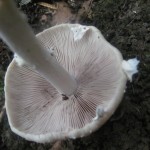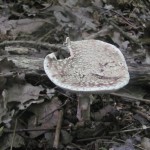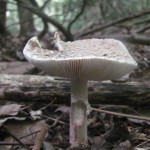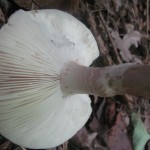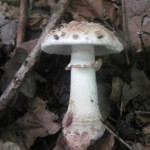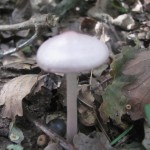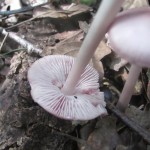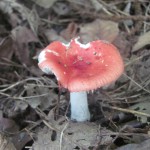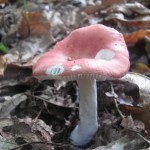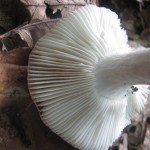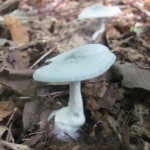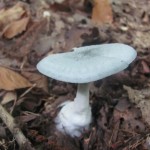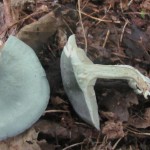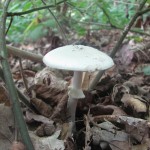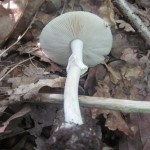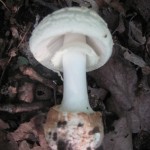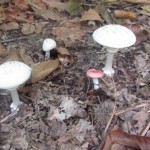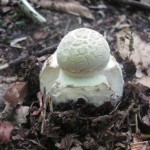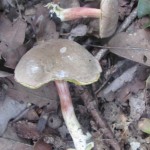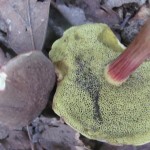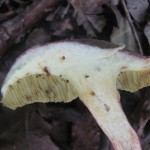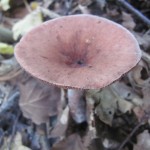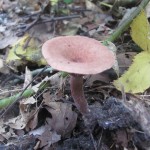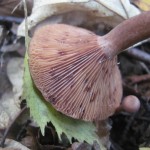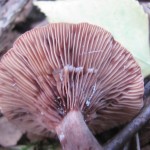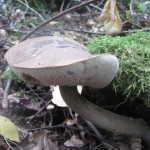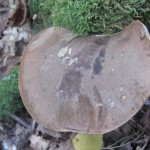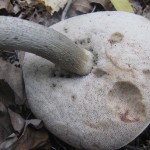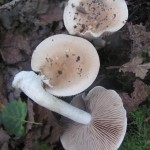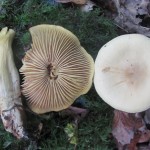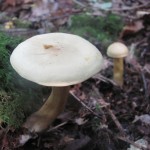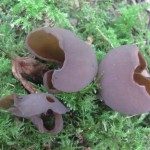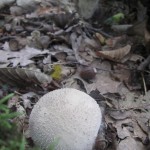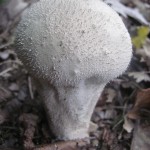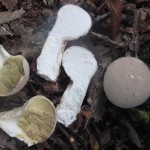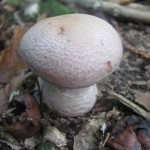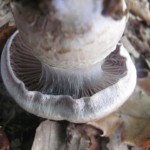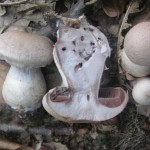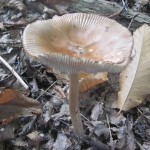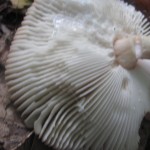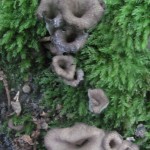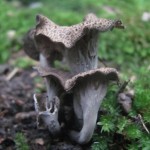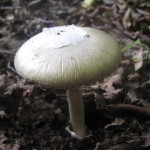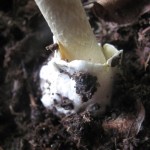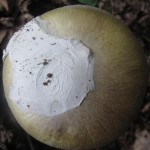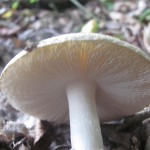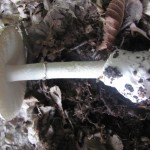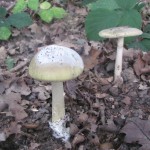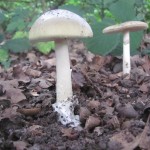A marvellous day! Late September is definitely the best time for fungi. Over 30 species including several edible ones and that’s without trying very hard. Lots as yet unidentified but most should be possible to sort them out later. Took 5 types home to eat: Curry Milkcap, Ochre Brittlegill, Bay Bolete (only 1), Common Puffball, and Horn of Plenty. (Had great fun telling people that I had been eating ‘Trumpet of Death Soup’. Very tasty soup just made of vegetable stock, a little fried onion, fried mushrooms, and cream.) The Horn of Plenty was a delight – first time I’ve found it. And there were some Deathcaps, which is always exciting – found a group of large ones hiding under a small oak.
1. Unidentified.
- 1. Unidentified
- 1. Unidentified
Tiny on stump. Cap 1cm. Difficult to identify as I only saw young ones. Could be young Sulphur Tuft but I don’t think so. Maybe Pholiota astragalina but this is unlikely.
2. Unidentified.
- 2. Unidentified
- 2. Unidentified
- 2. Unidentified
Growing on bare earth under beech. Cap 1-3cm. Smell mushroomy.
3. Curry Milkcap (Lactarius camphoratus).
- 3. Curry Milkcap
- 3. Curry Milkcap
- 3. Curry Milkcap
Growing on earth under beech. Curry smell slight at first but much stronger later. Milk dry and bitter.
5. Glistening Inkcap (Coprinus micaceus).
- 5. Glistening Inkcap
- 5. Glistening Inkcap
Growing on beech stump. Cap 2-5cm. Confused by this at first, but now think it’s just older Glistening Inkcap. ID is fairly likely.
6. Glistening Inkcap (Coprinus micaceus).
- 6. Glistening Inkcap
Growing on beech stump. Glistening Inkcap, growing on the same stump, smaller. ID is very likely.
7. Snapping Bonnet (Mycena vitilis).
- 7. Snapping Bonnet
Tiny. Snapping Bonnet probably, but could be another Bonnet. ID is fairly likely.
8. Type of Fibrecap.
- 8. Type of Fibrecap
- 8. Type of Fibrecap
Looks like a type of Fibrecap but not sure which.
9. Amethyst Deceiver (Laccaria amethystina).
- 9. Amethyst Deceiver
- 9. Amethyst Deceiver
- 9. Amethyst Deceiver
Lots. Probably an Amethyst Deceiver although I didn’t think so in the field. ID is fairly likely.
10. Unidentified.
- 10. Unidentified
- 10. Unidentified
Growing on huge sweet-chestnut tree. Medium 3cm and small/tiny jelly-like fruiting bodies.
11. Unidentified.
- 11. Unidentified
- 11. Unidentified
Growing on earth. Cap 1.5cm. White cap.
12. Pluteus ephebeus.
- 12. Pluteus ephebeus
- 12. Pluteus ephebeus
- 12. Pluteus ephebeus
Growing near oak, but other trees around. Cap 8cm. Slightly perfumed smell. ID is fairly likely.
13. Type of Amanita.
- 13. Type of Amanita
- 13. Type of Amanita
14. Ochre Brittlegill (Russula ochroleuca).
- 14. Ochre Brittlegill
- 14. Ochre Brittlegill
- 14. Ochre Brittlegill
- 14. Ochre Brittlegill
- 14. Ochre Brittlegill
- 14. Ochre Brittlegill
15. Bay Bolete (Boletus badius).
- 15. Bay Bolete
- 15. Bay Bolete
- 15. Bay Bolete
ID is almost sure.
16. Type of Russula.
- 16. Type of Russula
- 16. Type of Russula
Lots. Fairly big. No smell. Dark grey Russula? No smell.
17. Purple Russula (Russula atropurpurea).
- 17. Purple Russula
Old Purple Brittlegill. ID is very likely.
18. Brown Rollrim (Paxillus involutus).
- 18. Brown Rollrim
- 18. Brown Rollrim
Poisonous.
19. Unidentified.
- 19. Unidentified
- 19. Unidentified
Growing under yew tree. Cap 5cm+. No smell.
20. The Blusher (Amanita rubescens).
- 20. The Blusher
- 20. The Blusher
- 20. The Blusher
- 20. The Blusher
ID is very likely.
21. Unidentified.
- 21. Unidentified
- 21. Unidentified
Growing under yew. Cap 2-3cm. Buggy smell.
22. Type of Russula.
- 22. Type of Russula
- 22. Type of Russula
- 22. Type of Russula
Very hot taste. Red/pink Russula.
23. Aniseed Funnel (Clitocybe odora).
- 23. Aniseed Funnel
- 23. Aniseed Funnel
- 23. Aniseed Funnel
Growing directly leaf litter. Strong smell even with nose 1 foot away. Edible but I didn’t bother.
24. White False Deathcap (Amanita citrina).
- 24. White False Deathcap
- 24. White False Deathcap
- 24. White False Deathcap
- 24. White False Deathcap
- 24. White False Deathcap
Lots. Cap 5-8cm. Smell faintly of raw potato? ID is very likely.
25. Red Cracking Bolete (Boletus chrysenteron).
- 25. Red Cracking Bolete
- 25. Red Cracking Bolete
- 25. Red Cracking Bolete
26. Curry Milkcap (Lactarius camphoratus).
- 26. Curry Milkcap
- 26. Curry Milkcap
- 26. Curry Milkcap
- 26. Curry Milkcap
Under oak. Only a little milk.
27. Wood Bolete (Buchwaldoboletus lignicola).
- 27. Wood Bolete
- 27. Wood Bolete
- 27. Wood Bolete
Growing from dead wood. Colour for this species should be paler, but this is the only boletus that grows on dead wood. ID is best guess.
28. Unidentified.
- 28. Unidentified
29. Sulphur Knight (Tricholoma sulphureum).
- 29. Sulphur Knight
- 29. Sulphur Knight
Growing on rotten wood? Not sure. Cap up to 8cm. Strong smell of paint – very strange! The book says Sulphur Knight smells of gas tar but I’m not familiar with that lovely aroma. ID is fairly likely.
30. Jelly Ear (Auricularia auricula-judae).
- 30. Jelly Ear
Jelly Ear or similar. ID is fairly likely.
31. Common Puffball (Lycoperdon perlatum).
- 31. Common Puffball
- 31. Common Puffball
- 31. Common Puffball
32. Type of Webcap.
- 32. Type of Webcap
- 32. Type of Webcap
- 32. Type of Webcap
Webcaps are generally poisonous.
34. Unidentified.
- 34. Unidentified
- 34. Unidentified
Big. No smell.
35. Horn of Plenty (Craterellus cornucopioides).
- 35. Horn of Plenty
- 35. Horn of Plenty
36. Deathcap (Amanita phalloides).
- 36. Deathcap
- 36. Deathcap
- 36. Deathcap
- 36. Deathcap
- 36. Deathcap
- 36. Deathcap
- 36. Deathcap
About 6. Small one under hornbeam, then lots under an oak.


